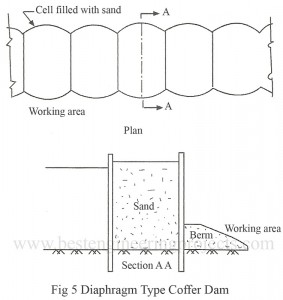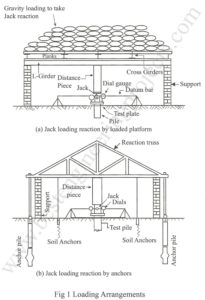The construction of pier consists of the following operations. They include excavation, placing of the concrete and inspection after construction. The excavation is done either manually or by machines. Manual excavation is done where the site is inaccessible to machines. Manual Method | Construction of Piers The manual methods which are in common use comprise: Chicago Method Gow Method Chicago Method – Chicago method is used exclusively in clay. In this method a cylindrical hole is excavated to a depth of 0.6 m in soft clay and 1.8 m in stiff…
Read MoreCategory: Civil Projects
Bearing Capacity of Piers | Piers in Sands
Piers transfer load from soft to strata. They derive resistance from shaft and base as in the case of piles. Qult = Qb + Qs = Abqb + Asqs = ———- (1) Piers in Sands | Bearing Capacity of Piers In sands resistance in most cases is derived from base only. Shaft resistance is usually neglected due to following reasons. Depth being less than five times the width When there is possibility of scour especially in bridge foundations If there is Compressible fill If soil is liable to shrink For sand…
Read MorePiers and Caissons | Function of Pears
What are Piers and Caissons? Piers and caissons are underground cylindrical structural members that serve same purpose as footing or piles. The purpose of these structures is to transmit loads to a stratum capable of supporting it without danger of breaking of the foundation soil or excessive settlement. Usually the ratio of depth to width for piers and caissons is greater than 5. Distinction between Piers and Caissons There is no sharp distinction between piers and caissons. In simple terms caissons are large piers. They differ only in the method…
Read MoreBraced Cofferdam | Types of Braced Cofferdam
Braced cofferdams are the sheeting and bracing systems to support walls of an excavation or to exclude water from an excavation. It is mostly used in urban areas. They are frequently used in the construction of bridge piers and abutments, The various components of braced cofferdams are: Laggings – Horizontal timber planks placed by hand as the excavation proceeds. Sheet piling – Timber, steel or concrete sheet piles installed vertically by driving. Soldier beams – Vertical beams of timber or steel for taking reaction from laggings. They are not required…
Read MoreCellular Cofferdams | Types of Cellular Cofferdams
A cellular cofferdam is constructed by driving sheet piles of special shapes to form a series of cells. The cells are interconnected to form a watertight wall. These are filled with soils to provide stability against the lateral forces. There are two types of cellular cofferdams, namely diaphragm type cellular cofferdam and circular type cellular cofferdam. Diaphragm Type cellular cofferdam | Cellular Cofferdams | Types of Cellular Cofferdams This type of cellular cofferdam consists of circular arcs at the inner and outer sides, which are connected by straight diaphragm walls. A…
Read MoreCofferdams | Types of Cofferdams
A cofferdam is a temporary enclosure in a river or lake built around a working area for the purpose of excluding ground water and water above ground level during construction. Types of cofferdams There are various types of cofferdams. They include: Cantilever Sheet Pile Cofferdam Braced Cofferdam Earth Embankment Cofferdam Rockfill Cofferdam Double Wall Cofferdam Cellular Cofferdam Cantilever Sheet Piles | Cofferdams | Types of Cofferdams Cantilever sheet piles are suitable for small head of water about 6 m. They are susceptible to large leakage and flood damage. They can be…
Read MoreComparison of Piles According to the Installation Methods
Table 1 Advantages and Disadvantages of the Piles According to the Different Installation Methods No. Advantage or Disadvantage Driven Piles Driven & Cast in place piles Bored Piles 1 Pile integrity can be cheeked prior to installation Yes(adv) No No 2 Pile can be driven to a pre-determined set (assuring that the bearing layer has been reached) Yes(adv) Yes No 3 Ease of construction when water table is present Yes(adv) No No 4 During installation the fresh concrete can be damaged due to ground water No(dis.) Yes Yes 5 Possible…
Read MoreConstruction of Pile Foundation
Driven and Cast-in-Piles Procedure Bored and Cast-in-Situ Piles Procedure
Read MorePile Load Test | Purpose of Pile Load Test
The purpose of pile load test is: To determine settlement under working load To determine ultimate bearing capacity To ascertain as a proof of acceptability Types of pile Load Test | Pile Load Test | Purpose of Pile Load Test In general two types of pile load tests are conducted. They are: Initial Test Routine Test The initial test is performed before the start of construction to assess the design adequacy. The routine test is performed on a working pile. This test is also known as work test. In initial test, the test…
Read MoreNegative Skin Fraction on Single Pile and on Pile Group
Negative skin friction on pile occurs when the surrounding soil settles relatively more than the pile, causing drag force that increases the load on the pile and resulting in the reduction of carrying capacity of the pile. Such settlement may be due to the weight of the superimposed as shown in Fig.1, to ground water lowering or as a result of disturbance of clay caused by pile driving. The additional load due to negative skin friction may be so large as to cause overstressing of the pile material or may…
Read More





